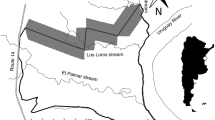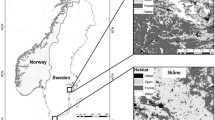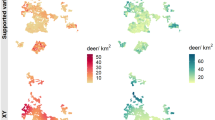Abstract
We investigated habitat use of Columbian black-tailed deer in urban Vancouver, Clark County, Washington, at 3 spatial scales: (1) placement of the annual home range within the landscape mosaic, (2) annual and seasonal locations of deer within the annual home range, and (3) short-term use of critical habitats (fawning areas) within seasonal ranges. Annual home range sizes of deer were 162 ha (SD = 133; 95% minimum convex polygon; MCP) and 266 ha (SD = 228; 95% adaptive kernel; AK) for does, and 756 ha (SD = 290; MCP) and 1,235 ha (SD = 382; AK) for bucks. Home range composition of does did not differ from the study area; home ranges of bucks contained more Natural ecological land-use cover types (ELUs) than did the study area. Within home ranges, both does and bucks used Natural ELUs more often than expected by their occurrence in the home range, both annually and seasonally. During the fawning season, does were also found in Natural ELUs more often than expected. Clark County-designated habitat corridors differed from both the study area and deer home ranges in habitat composition, primarily by containing more Natural and other undeveloped ELUs. Deer were located in habitat corridors more than expected. Deer in urban areas appear to use undeveloped habitat types for security. Management that maintains Natural ELUs, such as establishment of wildlife corridors, can provide important habitat components for black-tailed deer in urban habitats.
Similar content being viewed by others
References
Bender, L.C., Anderson, D.P. and Lewis, J.C. (2002) Ecology of black-tailed deer in urbanVancouver,Washington. Final report, Washington Dept. Fish and Wildl., Vancouver, p. 58.
Cornicelli, L., Woolf, A. and Roseberry, J.L. (1996) White-tailed deer use of a suburban environment in Southern Illinois. Trans. Illinois State Acad. Sci. 89, 93–103.
Dasmann, R.F. and Taber, R.D. (1956) Behavior of Columbian black-tailed deer with reference to population ecology. J. Mammal. 37, 143–164.
Efron, B. and Tibshirani, R.J. (1993) An Introduction to the Bootstrap. Chapman and Hall, New York, p. 436.
Etter, D.R., Hollis, K.M., Van Deelen, T.R., Ludwig, D.R., Chelsvig, J.E., Anchor, C.L. and Warner, R.E. (2002) Survival and movements of white-tailed deer in suburban Chicago, Illinois. J. Wildl. Manage. 66, 500–510.
Franklin, J.F. and Dyrness, C.T. (1973) Natural vegetation of Oregon and Washington. United States For. Serv. Gen. Tech. Rep. PNW-8.
Geist, V. (1980) Behavior: adaptive strategies in mule deer. In: Mule and Black-Tailed Deer of North America (O. C. Wallmo, ed.), pp. 157–223. Univ. Nebraska Press, Lincoln.
Grinder, M.I. and Krausman, P.R. (2001) Home range, habitat use, and nocturnal activity of coyotes in an urban environment. J. Wildl. Manage. 65, 887–898.
Grund, M.D., McAninch, J.B. and Wiggers, E.P. (2002) Seasonal movements and habitat use of female white-tailed deer associated with an urban park. J. Wildl. Manage. 66, 123–130.
Happe, P.J. (1982) The use of suburban habitats by the Columbian black-tailed deer. M.S. Thesis, Oregon State Univ., Corvallis.
Harris, S., Cresswell, W.J., Forde, P.G., Trewhella, W.J., Woollard, T. and Wray, S. (1990) Home-range analysis using radio-tracking data—a reviewof problems and techniques particularly as applied to the study of mammals. Mammal. Rev. 20, 97–123.
Hayne, D.W. (1949). Calculation of size of home range. J. Mammal. 30, 1–18.
Johnson, D.H. (1980). The comparison of usage and availability measurements for evaluating resource preference. Ecology 61, 65–71.
Livezey, K.B. (1991) Home range, habitat use, disturbance, and mortality of Columbian black-tailed deer in Mendocino National Forest. Cal. Fish and Game 77, 201–209.
Loft, E.R., Menke, J.W. and Burton, T.S. (1984) Seasonal movements and summer habitats of female black-tailed deer. J. Wildl. Manage. 48, 1317–1325.
McClean, S.A., Rumble, M.A., King, R.M. and Baker, W.L. (1998) Evaluation of resource selection methods with different definitions of availability. J. Wildl. Manage. 62, 793–801.
McCorquodale, S.M. (1999) Movements, survival, and mortality of black-tailed deer in the Klickitat Basin of Washington. J. Wildl. Manage. 63, 861–871.
McCullough, D.R., Jennings, K.W., Gates, N.B., Elliott, B.G. and DiDonato, J.E. (1997) Overabundant deer populations in California. Wildl. Soc. Bull. 25, 478–483.
McShea, W.J., Underwood, H.B. and Rappole, J.H. (1997) The Science of Overabundance: Deer Ecology and Population Management. Smithsonian Inst. Press, Washington, D.C. p. 402.
Miller, F.L. (1970) Distribution patterns of black-tailed deer (Odocoileus hemionus columbianus) in relation to environment. J. Mammal. 51, 248–260.
Miller, F.L. (1974) Four types of territoriality observed in a herd of black-tailed deer. In: The behavior of ungulates and its relation to management (V. Geist and F. R. Walther, eds.), vol.2, pp 644–660. IUCN, Morges, Switzerland.
Naef, V. and Bender, L.C. (1995) Merwin wildlife monitoring program status report: 1988–1993. Washington Dep. Fish and Wildl., Olympia.
Schoen, J.W. and Kirchhoff, M.D. (1985) Seasonal distribution and home range patterns of Sitka black-tailed deer on Admiralty Island, southeast Alaska. J. Wildl. Manage. 49, 96–103.
Ticer, C.L., Ockenfels, R.A. and deVos, J.C., Jr. (1998) Habitat use and activity patterns of urban-dwelling javelina. Urban Ecosystems 2, 141–145.
Waller, D.M. and Alverson, W.S. (1997) The white-tailed deer: a keystone herbivore. Wildl. Soc. Bull. 25, 217–226.
Wallmo, O.C. and Schoen, J.W. (1981) Forest management for deer. In: Mule and black-tailed deer of North America (O.C. Wallmo, ed.), pp 434–448. Univ. Nebraska Press, Lincoln.
Worton, B.J. (1989) Kernel methods for estimating the utilization distribution in home-range studies. Ecology 70, 164–168.
Worton, B.J. (1995) Using Monte Carlo simulation to evaluate kernel-based home range estimators. J. Wildl. Manage. 59, 794–800.
Zar, J.H. (1996) Biostatistical Analysis, 3rd ed. Prentice-Hall, Upper Saddle River, NJ.
Author information
Authors and Affiliations
Rights and permissions
About this article
Cite this article
Bender, L.C., Anderson, D.P. & Lewis, J.C. Annual and seasonal habitat use of Columbian black-tailed deer in urban Vancouver, Washington. Urban Ecosystems 7, 41–53 (2004). https://doi.org/10.1023/B:UECO.0000020171.51193.62
Issue Date:
DOI: https://doi.org/10.1023/B:UECO.0000020171.51193.62




